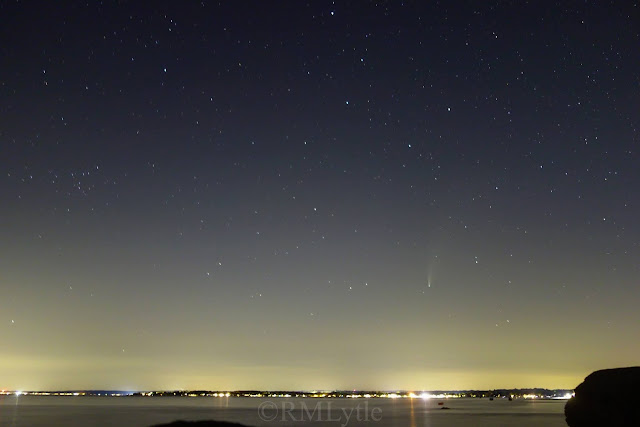we'd headed out that night bent on getting some dogfish. Dusky smooth hound, more specifically. These are a much maligned fish most places they're found. These benign little sharks are one of the most prominent of species considered "trash fish" in these waters. Ironically, they are also fantastic fighters and a quite good eating fish. This time we were just out to catch and release, and hopefully bring a few big ones to the boat. I quietly hoped for such an off-the-walls crazy good bite that I might be able to get one on the fly, but barring that I was more than happy to just cheat and skewer a chunk of eel on a big streamer and chuck it out there.
It was kind of impressive how rapidly it worked, as I was soon into a sizable dogfish, which bent the 10wt deeply and went on a blistering run. I put the metal to it and soon had the fish at the boat, still pretty green. Noah boated it for me, and it beat the piss out of him. To me, this is a great fish: a really cool animal, perfectly worthy of respect and admiration.
Fought on a fly rod, but most definitely not caught on the fly... I will though. But this night, that was the only dogfish of any real substantial size to come into the boat. I got two more tiny ones, and each Noah also got one cookie cutter small dog fish each. The original Noah took forever to get his, it was almost 4:00 a.m. by the time he did. So it was that we headed back east dog tired, into the scariest fog bank I've ever seen. We pointed at the faintly visible breakwater lighthouse, and as we plunged into the cloud everything else soon disappeared... if we lost sight of that lighthouse, and at times it was very faint, we were good and truly f***** until the sun burned off the fog. We never lost sight of it, but then had to slowly edge our way along the breakwater. After a time it became clear we needed to anchor and hookup the Q-Beam, which was more of a pain in the ass than it had any right to be. And once hooked up that really wasn't much use for navigation, but made me feel better about other boats seeing us, in spite of the bow and stern lights both being imperfect working order. At one point, I spotted some sort of animal waking at the surface and hit it with the light. To Noah and my shock, it then charged the stern and briefly looked like it may jump right in the boat. I suspect we'd interrupted an otter's morning hunt.
We pressed on slowly. I, having spent a fair bit of time on boats in thick fog by that time, was most comfortable. I tried to keep as level headed, calm and decisive as possible. And Noah, though he hated every bit of it, did a great job navigating us out of a dangerous situation. I'm honestly pretty proud of how well we handled that as a team. There's a lot of reasons Noah remains my favorite person to fish with, and his ability to deal with problems like this effectively is one of them.
Soon, the sun was setting the fog aglow in blue. Dawn was here, wed been out all night. We made it safely back to the launch. All that, for a handful of dogfish. Was it worth it? I think so.
We pressed on slowly. I, having spent a fair bit of time on boats in thick fog by that time, was most comfortable. I tried to keep as level headed, calm and decisive as possible. And Noah, though he hated every bit of it, did a great job navigating us out of a dangerous situation. I'm honestly pretty proud of how well we handled that as a team. There's a lot of reasons Noah remains my favorite person to fish with, and his ability to deal with problems like this effectively is one of them.
Soon, the sun was setting the fog aglow in blue. Dawn was here, wed been out all night. We made it safely back to the launch. All that, for a handful of dogfish. Was it worth it? I think so.
Until next time,
Fish for the love of fish.
Fish for the love of places fish live.
Fish for you.
And stay safe and healthy.
Fish for the love of fish.
Fish for the love of places fish live.
Fish for you.
And stay safe and healthy.
Thank you to my Patrons; Erin, David, John, Elizabeth, Brandon, Christopher, Shawn, Mike, Sara, Leo, and Franky for supporting this blog on Patreon.



















































